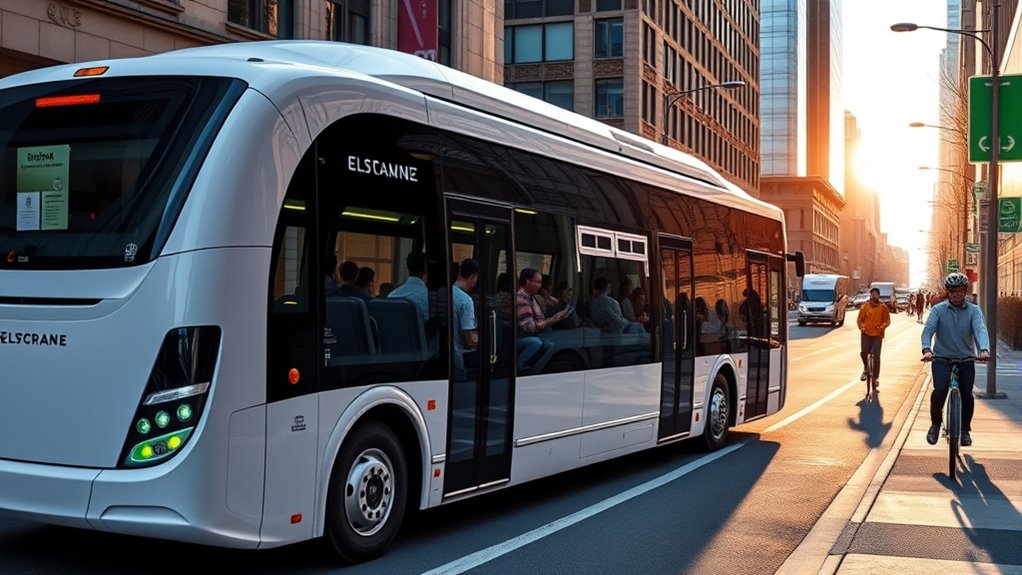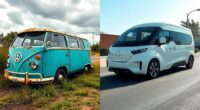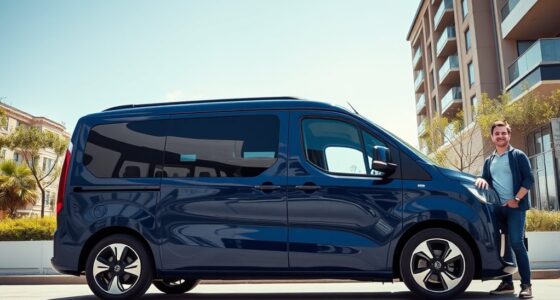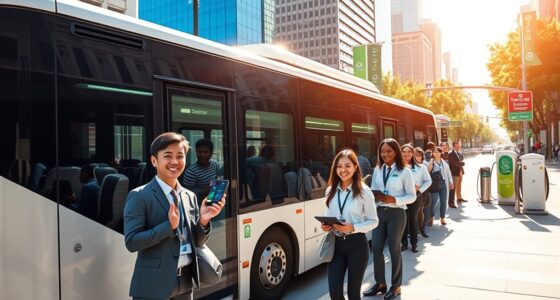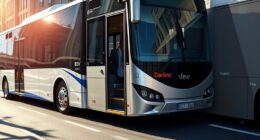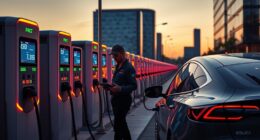Electric buses have considerably improved your daily commute by making rides quieter and smoother, reducing noise and air pollution in your city. They cut down on harmful emissions, helping the environment and your health. Lower operating costs mean transit agencies can keep fares affordable and reduce delays caused by breakdowns. Advanced charging and battery technology also support flexible routes and quicker stops. Keep exploring to discover how these innovations are shaping a cleaner, safer urban transit experience.
Key Takeaways
- Electric buses reduce air pollution and greenhouse gases, leading to healthier urban environments.
- They operate more quietly, decreasing noise pollution and creating a more peaceful commute.
- Lower maintenance and operating costs result in more affordable fares and improved service reliability.
- Advanced charging and battery technology enable flexible routes and quick recharging during stops.
- The shift to electric buses supports sustainability goals and promotes cleaner, greener public transportation.
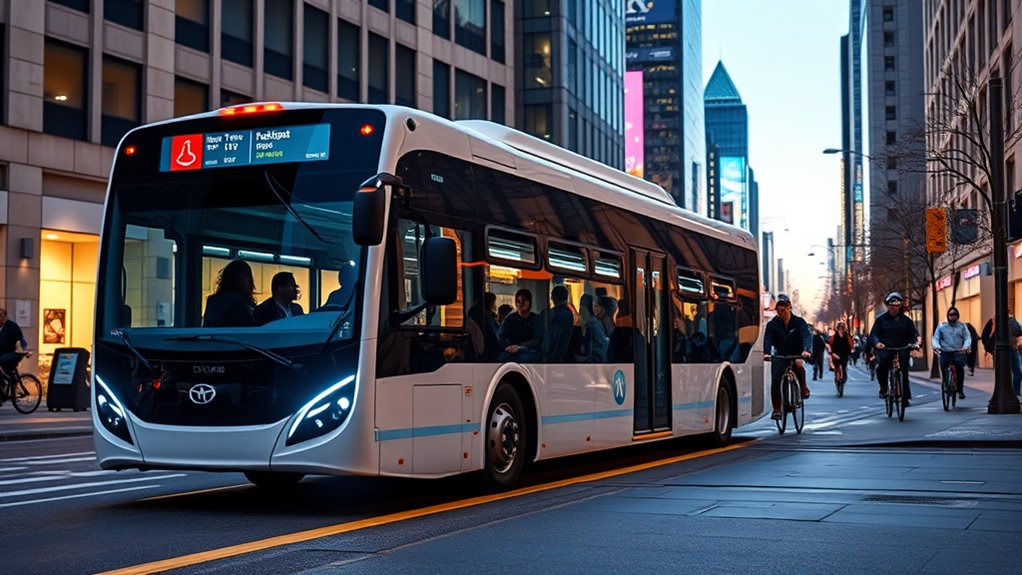
Electric buses are transforming daily commutes by offering a cleaner, quieter, and more sustainable transportation option. When you step onto an electric bus, you immediately notice how much quieter it’s compared to traditional diesel-powered vehicles. This quieter ride creates a peaceful environment, reducing noise pollution in busy urban areas and making your daily journey more comfortable.
Electric buses provide a quieter, cleaner, and more comfortable urban travel experience.
Additionally, electric buses produce zero tailpipe emissions, which means no harmful pollutants are released into the air as you travel. This considerably improves urban air quality, especially in densely populated cities where air pollution often reaches hazardous levels. By reducing emissions, electric buses play a crucial role in combating climate change, emitting far fewer greenhouse gases than their diesel or natural gas counterparts.
You also benefit financially from this shift. Electric buses tend to cost less to operate because electricity is cheaper than diesel, and they require less maintenance due to fewer moving parts. This translates into lower operating costs for transit agencies, which can help keep fares affordable for you. Plus, the reliability of electric buses means fewer breakdowns and delays, ensuring your daily commute remains predictable and punctual.
As cities invest in charging infrastructure—using efficient systems like socket charging and regenerative braking—electric buses can quickly recharge during short stops, maintaining their routes without long downtimes. Some transit systems are even exploring renewable energy sources to power these buses, further reducing their environmental footprint. Moreover, advancements in advanced battery technology are enabling electric buses to cover longer distances on a single charge, increasing their adaptability to various transit routes. Incorporating smart charging systems can also optimize energy use and reduce grid impacts.
From a health perspective, electric buses considerably cut your exposure to harmful particulates and pollutants associated with traditional diesel engines. This results in cleaner air and contributes to better overall public health. Fewer emissions mean fewer respiratory problems and lower mortality rates linked to air pollution, making your daily travel not only more comfortable but healthier too.
With a smoother and quieter ride, your stress levels are likely to decrease, transforming your commute from a stressful experience into a more pleasant part of your day. Additionally, the deployment of electric buses supports the transition to renewable energy, aligning transportation with broader sustainability initiatives.
Furthermore, the integration of renewable energy sources ensures that the electricity powering these buses is increasingly sustainable, amplifying their environmental benefits. By replacing fossil fuel-powered buses with electric ones, cities are actively reducing their carbon footprint, supporting climate change mitigation efforts. This shift aligns with broader sustainability goals, encouraging the adoption of green transportation options.
While the initial investment in charging infrastructure might seem high, it’s offset over time by the savings on fuel and maintenance, ultimately making electric buses an economically sound choice. All these factors combine to make your daily commute safer, cleaner, and more sustainable, shaping a future where transportation is kinder to both people and the planet.
Frequently Asked Questions
How Do Electric Buses Handle Extreme Weather Conditions?
You’ll find that electric buses handle extreme weather better with improved traction and stability, thanks to even battery weight. However, cold temperatures diminish their range by up to a third because heating systems and battery warming use extra energy.
To cope, you’ll need route planning, preconditioning, and insulation upgrades. Drivers report better handling in snow, but it’s essential to manage heating and battery health to guarantee reliable operation in freezing conditions.
What Is the Lifespan of an Electric Bus Battery?
You might wonder about the lifespan of an electric bus battery. Typically, it lasts 5 to 7 years under normal conditions, but with proper maintenance, it can go over 10 years.
Batteries like CATL’s Tectrans are designed for up to 15 years or 1.5 million kilometers.
Factors like temperature, charging habits, and battery type influence longevity.
After use, batteries can be repurposed or recycled, extending their overall life cycle.
Are Electric Buses More Cost-Effective Long-Term Than Diesel Buses?
You might think electric buses are too costly upfront, but they’re more cost-effective long-term. While they cost more initially, they save you up to $50,000 annually through lower fuel and maintenance costs.
Over their lifespan, you’ll see savings of about $525,000, making them a smart investment. Their efficiency and environmental benefits further boost their long-term value, often paying back the higher initial price within five years.
How Do Charging Times Impact Daily Bus Schedules?
Charging times directly impact your daily bus schedule by requiring adjustments to routes and departure times. You’ll notice longer waits during charging, which can reduce bus frequency and extend travel times.
To keep things running smoothly, schedules are often shifted to off-peak hours or overnight, ensuring buses are ready without disrupting your commute. Efficient infrastructure and charging strategies help minimize delays and keep your journey reliable.
What Are the Challenges in Implementing Electric Bus Infrastructure?
When it comes to implementing electric bus infrastructure, you face a tough nut to crack. You need to juggle high upfront costs, from buses to charging stations, often relying on grants to ease the burden.
Managing limited charging stations and designing routes to match charging times adds complexity. Plus, coordinating with energy providers and training staff makes the process even more challenging, but it’s essential for a smooth progression.
Conclusion
As you see, electric buses are transforming daily commutes by reducing emissions and noise. While some skeptics argue they can’t meet all transit needs yet, recent advancements prove otherwise. The technology is evolving rapidly, making electric buses more reliable and affordable. So, it’s likely that in the near future, your daily ride could be cleaner, quieter, and more sustainable, confirming the theory that electric buses are truly revolutionizing urban transportation for good.
